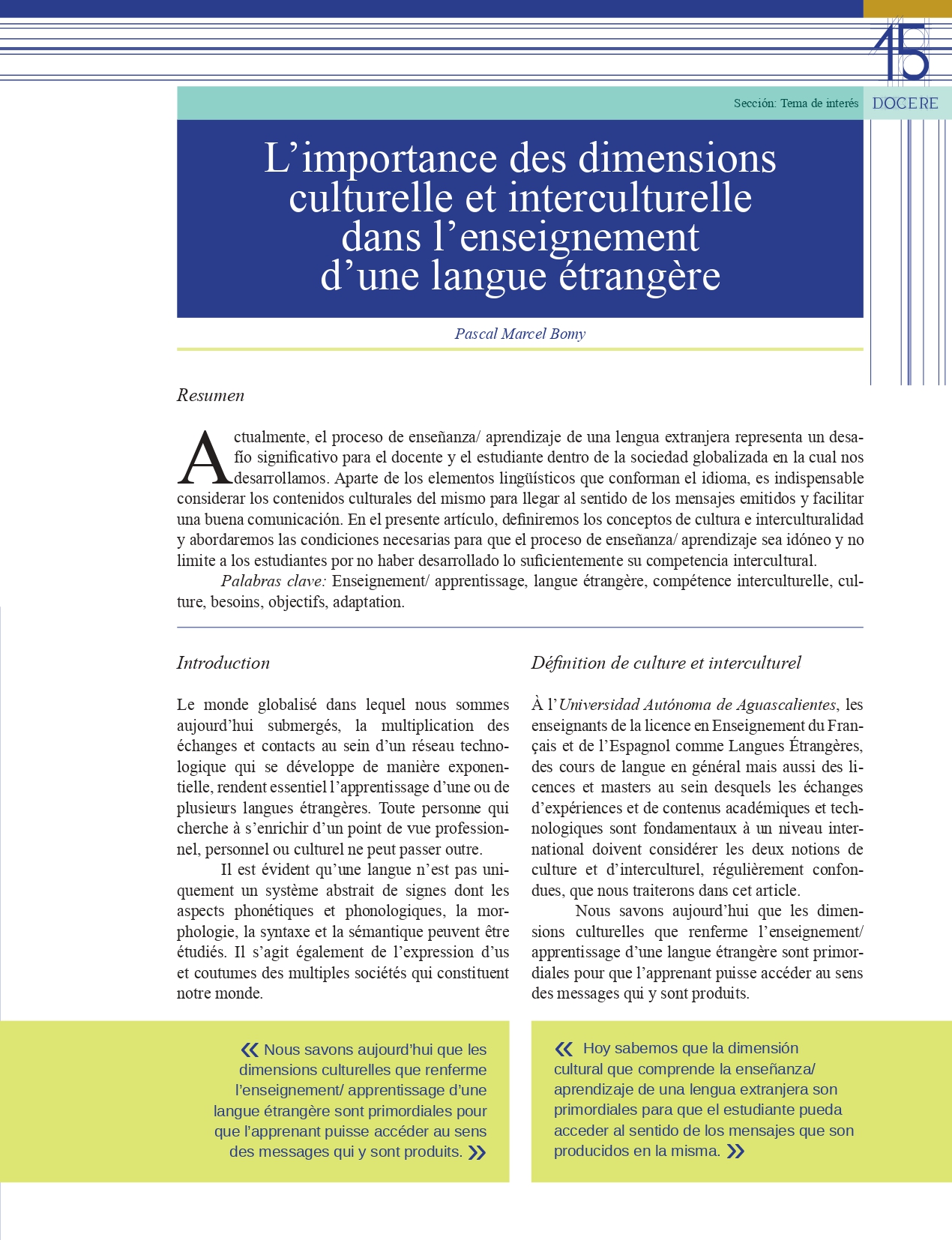The importance of Cultural and Intercultural dimensions in Teaching a Foreign Language (Article in French)
DOI:
https://doi.org/10.33064/2018docere181387Keywords:
foreign language, intercultural competence, culture, needs, objectives, adaptation, teaching/learningAbstract
Nowadays, the teaching/learning process of a foreign language represent a meaningful challenge for the professor and the student within the globalized society on which we develop. On top of the linguistic elements that make up the language, it is essential to consider the cultural contents of it to get to the meaning of the emitted messages and facilitate a good communication. In this article, we will define the concepts of culture and interculturality and we will address the needed conditions so the teaching/learning process is ideal and does not limit the students for not developing their intercultural competence sufficiently.
Translated by Rafael Guzmán De Luna.
Downloads
References
Beacco, J.-C. (2000). Les dimensions culturelles des enseignements de langue. France: Hachette. Cadre européen commun de référence pour les langues. (2001). France: Didier.
Cuq, J.-P., Gruca, I. (2002). Cours de didactique du Français Langue Étrangère et Seconde. France: PUG.
LACE. (2007). The LACE (Language and Cultures in Europe). Report: The Intercultural Competences Developed in Compulsory Foreign Languages Education in The European Union. The Eupopean Commission: DG Education, Training. Culture and Multililngualism. Available in English, German and French at: http://ec.europa.eu/education/policies/lang/key/studies en html (accessed 11 oct. 2008).
Mourlhon-Dallies, F. (2008). Enseigner une langue à des fins professionnelles. France: Didier.
Porcher, L., Abdallah-Pretceille, M. (1998). Éthique de la diversité et éducation. France: PUF.
Puren, C. (2013). La compétence culturelle et ses composantes. Savoirs et formations, N°3, pp. 6-15. Consulté le 26 août 2017, sur http://lewebpedagogique.com/alterite/files/2015/10/PUREN_2013c_Comp%C3%A9tence_culturelle_composantes.pdf.
Spencer-Oatey, H. (2005). Rapport management theory and culture. Intercultural Pragmatics, 2-3: 335-46.
Spencer-Oatey, H., Franklin, P. (2009). Intercultural Interaction: A Multidisciplinary Approach to Intercultural Communication, United Kingdom: Palgrave Macmillan.

Downloads
Published
How to Cite
Issue
Section
License
Esta obra está bajo una Licencia Creative Commons Atribución-NoComercial-CompartirIgual 4.0 Internacional.
El lector y/o usuario que utilice el material publicado en la revista DOCERE de la Universidad Autónoma de Aguascalientes, deberá en todos los casos: a) Reconocer la autoría del material utilizado, proporcionando un enlace a la licencia, además de indicar sí se han realizado cambios al material; b) Queda prohibido utilizar el material proveniente de la revista DOCERE, con finalidad comercial y, C) En los casos en los que se realice la remezcla, transformación o creación, a partir del material publicado de la revista DOCERE, se deberá dar reconocimiento de los derechos que correspondan a la Universidad Autónoma de Aguascalientes, en su carácter de titular de la materia protegible utilizada. En caso de infracción a lo antes dispuesto, el lector y/o usuario, se hará acreedor a las sanciones que establece la legislación de la materia.












